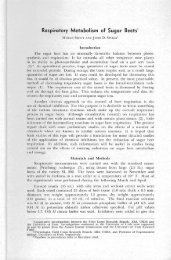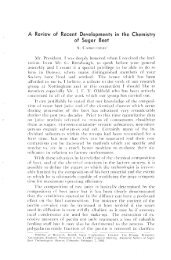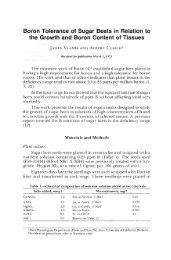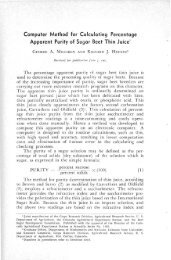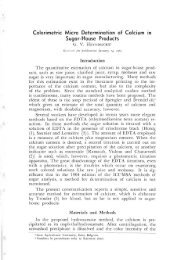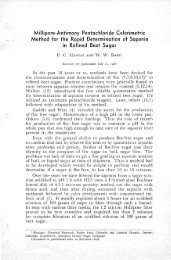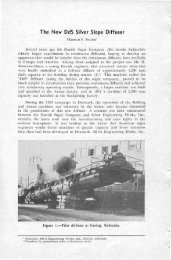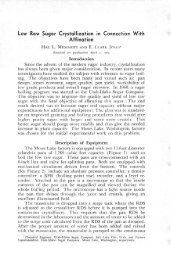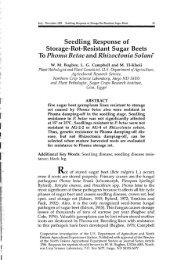Journal of Sugar Beet Research - Vol
Journal of Sugar Beet Research - Vol
Journal of Sugar Beet Research - Vol
Create successful ePaper yourself
Turn your PDF publications into a flip-book with our unique Google optimized e-Paper software.
36 <strong>Journal</strong> <strong>of</strong> <strong>Sugar</strong> <strong>Beet</strong> <strong>Research</strong> <strong>Vol</strong>. 45 Nos. 1 & 2<br />
contrast statements. Bartlett’s Test was used to evaluate homogeneity<br />
<strong>of</strong> variance.<br />
ReSuLTS<br />
Temperature. During the 2005/2006 storage season temperatures<br />
dropped below 0°C on 3 December 2005 and stayed below zero for the<br />
next 29 days (Fig. 1). The lowest temperature during the cold period<br />
was -7.9°C. Temperatures then remained above 0°C for all but two<br />
days until the end <strong>of</strong> the storage season. During the 2006/2007 storage<br />
season temperatures dropped below 0°C for 2 days at the end <strong>of</strong> October<br />
and then not again until 25 December 2006. Temperatures fluctuated<br />
above and below freezing until mid February when they remained above<br />
freezing until the end <strong>of</strong> the storage season. The coldest temperature<br />
recorded was -5.7°C on 17 January 2007.<br />
Curly top ratings. During the 2005 growing season moderate curly<br />
top disease pressure was present based only on natural leafhopper<br />
movement. By 7 September the mean curly top ratings for HM PM21,<br />
Beta 8600, and HH Phoenix R without Poncho Beta were 2.7, 3.7, and<br />
5.3, respectively [LSD (P < 0.05) = 0.5]. With Poncho Beta, the same<br />
three cultivars had ratings <strong>of</strong> 1.5, 2.1, and 3.8, respectively (Strausbaugh<br />
et al. 2006). When analyzed across cultivars, the Poncho Beta treatment<br />
readings averaged 1.97 lower (P < 0.01) than treatment without<br />
the insecticide. During the 2006 growing season there was moderate<br />
disease pressure based on inoculation with viruliferous leafhoppers. By<br />
12 September the mean curly top ratings for HM PM90, Beta 8600, and<br />
HH Phoenix R without Poncho Beta were 3.7, 4.0, and 4.5, respectively<br />
[LSD (P < 0.05) = 0.4]. With Poncho Beta, the same three cultivars had<br />
ratings <strong>of</strong> 2.5, 2.7, and 3.2 respectively. When analyzed across cultivars,<br />
the Poncho Beta treatment readings averaged 1.3 lower (P < 0.01) than<br />
treatments without the insecticide.<br />
Surface rot. There was no apparent surface rot in the November sampling<br />
during either year. December data for surface rot from 2005 and<br />
2006 were analyzed together since they were not significantly different<br />
(P = 0.15) and variances were homogeneous (P = 0.08). January data<br />
for surface rot did not differ between years (P = 0.12), but variances<br />
were not homogeneous (P = 0.03). Thus, these data were analyzed<br />
individually. February data for surface rot differed between years (P <<br />
0.01). Roots from the 2005 growing season did not differ in surface rot<br />
throughout the storage season (Table 1). In roots from the 2006 growing<br />
season, treatments differed for surface rot in January. HH Phoenix



